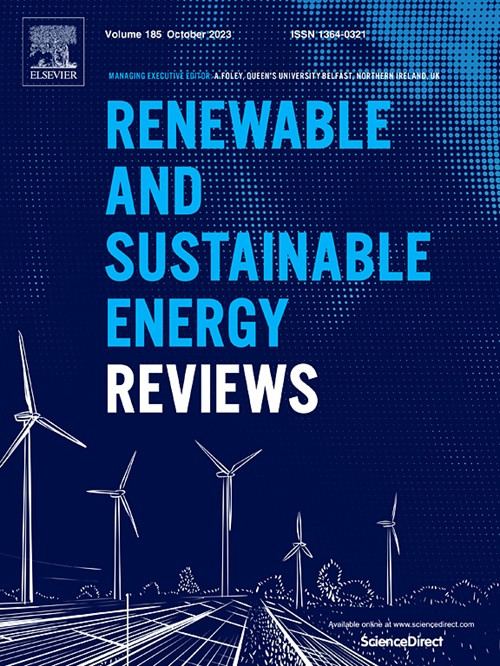A comprehensive review on definitions, development, and policies of net-zero carbon buildings (nZCBs)
IF 16.3
1区 工程技术
Q1 ENERGY & FUELS
引用次数: 0
Abstract
The energy consumption and carbon emissions of the building sector are expected to rise significantly in the near future. Net-zero carbon buildings (nZCBs) have emerged as a critical area of research to reduce fossil energy use and greenhouse gas emissions in the building sector. In recent years, leading economic bodies, including China, the United States, Canada, and the European Union etc., have made substantial efforts to advance nZCB initiatives. This study aims to provide a comprehensive understanding of nZCBs through three key objectives in leading economic bodies while carrying out a more in-depth analysis of progress in China. First, it reviews and compares nZCB definitions in leading economic bodies, emphasizing critical parameters and boundary conditions. It also investigates the distinctions and overlaps between nZCBs and net-zero energy buildings (nZEBs), providing valuable insights into their unique features. Second, the study outlines mid-to-long term goals for achieving large-scale implementation at various levels, and further investigates the development and current progress of nZCBs in China, and highlights key achievements and pilot projects. Third, the study analyzes various national policies and regional policies, regulations, and guidelines shaping nZCBs development. Additionally, it evaluates certification systems for nZCBs in leading economic bodies, integrating regional characteristics, renewable energy distribution, and diverse building types, and sets carbon emission limits tailored to climate zones and solar radiation levels. This study offers critical insights and strategic recommendations to accelerate nZCB adoption, contributing to long-term sustainability objectives.
净零碳建筑的定义、发展和政策综述
在不久的将来,建筑行业的能源消耗和碳排放预计将大幅上升。净零碳建筑(nzcb)已成为减少建筑行业化石能源使用和温室气体排放的关键研究领域。近年来,包括中国、美国、加拿大、欧盟等在内的主要经济机构为推进纽加央行倡议做出了大量努力。本研究旨在通过主要经济机构的三个关键目标,提供对新西兰银行的全面了解,同时对中国的进展进行更深入的分析。首先,它回顾和比较了主要经济机构的nZCB定义,强调了关键参数和边界条件。它还调查了nzcb和净零能耗建筑(nzeb)之间的区别和重叠之处,为它们的独特之处提供了有价值的见解。其次,本研究概述了在各个层面实现大规模实施的中长期目标,并进一步调查了nzcb在中国的发展和现状,突出了重点成果和试点项目。第三,分析了影响nzcb发展的各种国家政策和区域政策、法规和指导方针。此外,它还评估主要经济机构的nzcb认证体系,整合区域特征、可再生能源分布和各种建筑类型,并根据气候区域和太阳辐射水平设定碳排放限制。本研究为加快nZCB的采用提供了重要的见解和战略建议,有助于实现长期可持续发展目标。
本文章由计算机程序翻译,如有差异,请以英文原文为准。
求助全文
约1分钟内获得全文
求助全文
来源期刊

Renewable and Sustainable Energy Reviews
工程技术-能源与燃料
CiteScore
31.20
自引率
5.70%
发文量
1055
审稿时长
62 days
期刊介绍:
The mission of Renewable and Sustainable Energy Reviews is to disseminate the most compelling and pertinent critical insights in renewable and sustainable energy, fostering collaboration among the research community, private sector, and policy and decision makers. The journal aims to exchange challenges, solutions, innovative concepts, and technologies, contributing to sustainable development, the transition to a low-carbon future, and the attainment of emissions targets outlined by the United Nations Framework Convention on Climate Change.
Renewable and Sustainable Energy Reviews publishes a diverse range of content, including review papers, original research, case studies, and analyses of new technologies, all featuring a substantial review component such as critique, comparison, or analysis. Introducing a distinctive paper type, Expert Insights, the journal presents commissioned mini-reviews authored by field leaders, addressing topics of significant interest. Case studies undergo consideration only if they showcase the work's applicability to other regions or contribute valuable insights to the broader field of renewable and sustainable energy. Notably, a bibliographic or literature review lacking critical analysis is deemed unsuitable for publication.
 求助内容:
求助内容: 应助结果提醒方式:
应助结果提醒方式:


